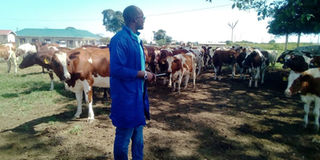Uganda imports 255 heads of cattle from S.Africa to boost dairy production

Mr Godfrey Rwakabura, the manager of Entebbe National Quarantine Centre inspects the imported Ayrashire cows on April 5,2022. PHOTOS/ FRED MUZAALE
What you need to know:
- According to Uganda Dairy Development Authority Uganda has an annual milk production of 2.81billion litres with annual dairy exports worth Shs750billion.
- Lusenke and Kasolwe farms were ruined during Amin and Obote regimes, which resulted in at least 2,000 encroachers grabbing big chunks of the farms’ land.
Government of Uganda through the National Animal Genetic Resources Centre and Data Bank (NAGRC & DB) has imported 255 in-calf superior dairy breeding heads of cattle for the establishment of an intensive dairy production and breeding units.
According to Dr Peter Beine, the NAGRC &DB executive director, the cows which include; 122 in-calf Jerseys and 133 Ayrshire dairy cows were imported from South Africa two months ago. He however declined to reveal how much money has been spent on the project.
“These superior dairy breeding cattle are to be taken to Lusenke and Kasolwe stock farms located in Kayunga and Kamuli districts respectively for purposes of establishing a demonstration of intensive dairy production and breeding units,” Dr Beine said in an interview on Tuesday.
Both Kasolwe and Lusenke stock farms, Dr Beine disclosed, are supposed to be turned into centres of excellence in dairy production in the country.
Dr Beine, however, said the animals are still under quarantine at the National Livestock quarantine centre, Entebbe, where they would be kept for three months under close monitoring and supervision.
“The livestock would be kept at the centre for three months for purposes of ascertaining their health status and acclimatization issues after which they would be taken to their final destination,” Dr Beina said.
He said for the period the cows have been under quarantine, they have produced 160 calves.
Both breeds (Jersey and Ayrshire) are high quality milk producers, have a long productive life, have strong hooves, tolerant to varying climates and generally have good health with low rates of calving issues.
Although Mr Bright Rwamirama, the state minister for animal industry had last year disclosed that a total of 400 dairy cows would be imported from South Africa and Switzerland, it is not yet clear whether another batch of dairy cows would be procured from Switzerland as indicated by the minister.

A worker feeds the Jersey cows at Entebbe national quarantine centre on April 5,2022
Lusenke and Kasolwe farms were ruined during Amin and Obote regimes, which resulted in at least 2,000 encroachers grabbing big chunks of the farms’ land.
However, government in 2006 started on a programme to revamp them with a view of turning them into centres of excellence for breeding animals, poultry and piggery in the country.
Currently, Dr Beine said, they are still battling with encroachers to leave the land with some dragged to courts of law.
The NAGRC& DB boss also disclosed that they would use the genetics of the Ayrshire and Jersey breeds to cross with indigenous genetics to get better breeds.
He added that a community breeding program in both areas to benefit surrounding communities is ongoing.
“We shall also carry out embryo transfers with the two cattle breeds for breed improvement under the embryo transfer services unit for pure breed multiplication,” Dr Beine said.
“Under the breed improvement program, Farmers would be allowed to buy improved dairy breeds from our farms at a subsidized cost,” he added.
While touring Lusenke Stock Farm last year, Mr Rwamirama disclosed that he wants the farm to concentrate on breeding of dairy cows to serve the central region adding that they are still discussing whether they can also bring dairy goats at the farm.
Mr Sam Ntege, a cattle farmer in Nkokonjeru village, Kitimbwa Sub County in Kayunga District said the breeding programme would help them increase their milk production.
“My local cow produces only eight liters of milk a day, which is very little. If I get cross breeds I would be able to get milk for my family’s consumption and for sale,” Mr Ntege said.
Some parts of Kamuli and Kayunga districts are located in the cattle corridor, where many of the cattle keepers are herding indigenous breeds that give them little milk and beef.
According to Uganda Dairy Development Authority Uganda has an annual milk production of 2.81billion litres with annual dairy exports worth Shs750billion. This rise is attributed to the expansion of milk collection centres across the country. Currently, there are 483 milk collection centres countrywide with a total installed capacity of 1,938,522 litres .These centres are operated by dairy cooperatives, private individuals, companies and processors




